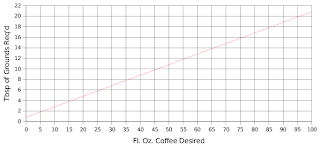Public Service Announcement
PSA: Don’t follow Starbucks’ directions for making coffee if you like it black.
Backstory: I usually make four cups of coffee whenever I need some. I’m feeling particularly lazy (it’s a Saturday and I got excused from going into the office to get shot at) and I’d like to get some exercise, so I put a pot on. That’s four cups based on the coffee pot markings. Starbucks’ directions say use 2 Tbsp (10 grams) per 6 fl oz. water. I use a 1/8 cup scoop, so that’s one scoop per 6 oz. I measured the markings on the pot, and they indicate about 5 oz. per cup, at least to the 4 cup and 6 cup markings. It’s a Mr. Coffee given to me by an ex-girlfriend.
Anyway, that means slightly less than one scoop per cup, well, I usually use one scoop per 2 cups. So, the coffee will be pretty strong for my taste. The directions also say that the whole bag (70 grams of coffee) is the right amount for one 12 or 10 cup pot of coffee. 70 grams is seven scoops. According to the initial directions, seven scoops is only enough for 42 oz of coffee. That means the markings on your coffee pot would have to indicate either 4.2 or 3.5 oz cups of coffee. That’s not a whole lot of coffee per cup, even my pot’s 5 oz isn’t a whole lot, that’s why I make 4 cups for just me.
All this indicates that the relationship between grams of grounds and oz of coffee produced is not linear. This isn’t really a surprising result, but it seems like bags of grounds should indicate this on the bag with a graph or something. “Fluid ounces of coffee to make” on the X axis and “tbsp of grounds required” on the Y. In the interest of killing boredom, and delaying my exercise, I’ve produced an initial graph assuming a linear relationship (linear in the electrical engineering sense, as in, it’s a straight line). It seems more likely that this relationship is not truly linear, but I think other things like the shape of the grounds holder, the strength of the filter, and the temperature of the water as it’s fed into the grounds will make more of a difference in taste than any break from linearity at a huge number of cups.

The graph is based on the two data points given in the Starbucks directions… 2 tbsp for 6 oz, and 14 tbsp for an 11 cup pot. I make the assumption that a 11 cup pot refers to a 66 fl. oz. pot, as it seems like most manufacturers use 6 fl. oz. as their cup size (based on a Google search). Note that the graph shows that zero cups of coffee still require some grounds (.8 tbsp). This doesn’t make sense, and indicates that the relationship is actually non-linear.
Anyway, the important result, and the reason I started all this, was to determine how strong an “official Starbucks” cup of coffee was compared to my typical cup of coffee. I make about 20 fl. oz. of coffee, and use two scoops, or 4 tbsp of grounds. My results indicate Starbucks would say should use 4.8 tbsp of grounds. That’s pretty strong for my taste.
Back to the instructions on the bag, without all this math and using only the first guideline on the bag, I should use a little more than three scoops for my 20 fl. oz. I actually tried this and the coffee was DAMN strong. I added some hot water to make it drinkable…
I guess I have to go running now.